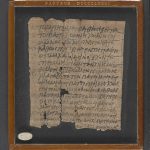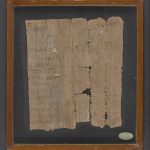| Artefact ID | 153 |
| TM ID | TM 33777 |
| Findspot (DEChriM ID) | 58 (Dayr al-ʿIẓām) | Class | Textual |
| Material | Papyrus |
| Writing medium | Sheet/roll |
| Text content | Documentary |
| Language | Greek |
| Archive/Dossier | Archive |
| Description | P.Lond. III 981 (p. 241); Chrest.Wilck. 130: Letter to Apa John. Beginning of a letter from the deacon Ioannes to his "beloved and most pious father Iohannes", with "greetings in the Lord" containing expressions of admiration ("Your fame, o father, went around the entire world as an excellent father"), and a mention of a meeting with the dux. Noteworthy are a quote of Is. 31.9 (introduced by καθὼς γέγραπται ἐν τῇ γραφῇ) and perhaps a reminiscence of Rom. I, 8 (Choat 2006: 74-75, 77).
This is one of many Greek and Coptic letters addressed by monks, clerics, soldiers, state officials and individuals to Apa John, so that he would intercede in their favour in dealings with the authorities or pray for them. The anchorite of this archive was identified with the famous John of Lykopolis known by literary sources by Zuckerman 1995.
Recto written along the fibres; large hand with a slight slant to the right; one nomen sacrum but abbreviated εν κυ(ρίῳ) with supralinear stroke above ενκυ; accent on νυκτἡμαρ. Verso blank. |
| Selection criteria | Mention of Christian cult officials/institutions, Christian terms/formulas/concepts, Nomina sacra, Biblical quote or paraphrase |
| Date from | 375 |
| Date to | 399 |
| Dating criteria | Palaeography and archive connection |
| Absolute/relative date | Relative date |
| Archaeological context | According to Constantine Zuckerman's reconstruction, the Apa John’s letters were presumably found in September 1897, during the excavations of Farag Ismael and Yassa Tadros on the mountain of Siout (Lykopolis), in the ruins of Dayr al-'Azam, the site of the monastery of John of Lycopolis. Yet they never reached the museum in Gizeh like the other objects unearthed during these excavations, and must have ended on the market, where they were bought soon after the excavations (Zuckerman 1995: 191-192; Van Minnen 1994: 80-82, Gonis 2008: 69-72). Although not proven, this attractive hypothesis is generally accepted by scholars (see discussion in Van der Vliet 2015: 166-167; some reservations in Choat 2017: 37-40). |
| Accession number | London, British Library, Pap 981 |
ARTEFACT IDENTIFIERS
Editio princeps:
• Kenyon, Frederic G. and Harold I. Bell. 1907. Greek Papyri in the British Museum, vol. III. London, 241-242, no. 981.
Additional bibliography:
• Choat, Malcolm and Maria Chiara Giorda. 2017. Writing and Communication in Early Monasticism. Texts and Studies in Eastern Christianity 9. Leiden, Boston.
• Choat, Malcolm. 2006. Belief and Cult in Fourth-Century Papyri. Studia Antiqua Australiensia 1. Turnhout: Brepols.
• Gonis, Nikolaos. 2008. “Further Letters from the Archive of Apa Ioannes.” Bulletin of the American Society of Papyrologists 45, 69-85.
• Llewelyn, Stephen. 1982. New Documents Illustrating Early Christianity, 2. Macquarie University: The Ancient History Documentary Research Centre, 157.
• Naldini, Mario. 1968. Il cristianesimo in Egitto. Lettere private nei papiri dei secoli II-IV. Studi e Testi di Papirologia. 3. Firenze: Le Monnier, no. 51.
• Van der Vliet, Jacques. 2015. “Snippets from the Past: Two ancient sites in the Asyut Region: Dayr al-Gabrawi and Dayr al-’Izam.” In Christianity and Monasticism in Middle Egypt, ed. Gawdat Gabra and Hany Takla. Cairo: The American University in Cairo Press, 161-168.
• Van Minnen, Peter. 1994. “The Roots of Egyptian Christianity.” Archiv für Papyrusforschung und verwandte Gebiete 41, 71-85.
• Wilcken, Ulrich. 1912. Grundzüge und Chrestomathie der Papyruskunde, I Bd. Historischer Teil, II Hälfte Chrestomathie. Leipzig-Berlin, 157, no. 130.
• Zuckerman, Constantine. 1995. "The Hapless Recruit Psois and the Mighty Anchorite, Apa John." Bulletin of the American Society of Papyrologists 32, 183-194.


 Json data
Json data





